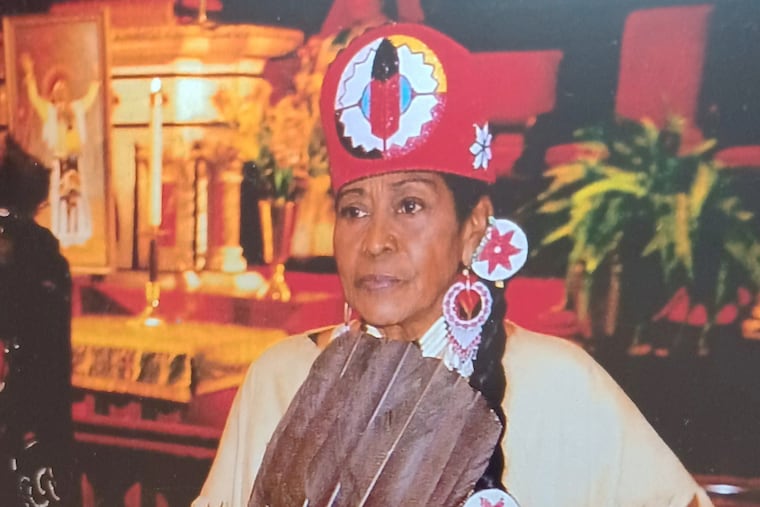Chief Buffy Red Feather Brown, a leader of the Pennsylvania Cherokee, dies at 93
She learned the Cherokee language after she became an adult and taught other Cherokee people in the Philadelphia area.

Chief Buffy Red Feather Brown, 93, of East Mount Airy, a longtime advocate for teaching and preserving Native American culture and history, died Saturday, Oct. 23, at the Visiting Nurse Association Hospice in Philadelphia.
She learned the Cherokee language after she became an adult and taught other Cherokee people in the Philadelphia area, said her daughter, Theresa Brown.
As a leader of the Southeastern Cherokee Confederacy of Pennsylvania-Earth Band, Chief Red Feather helped coordinate the annual Cherokee Indian Festival on Temple University’s Ambler campus.
“My mother was educating the community about Native American culture in the 1970s, long before it became popular, and long before she became a chief,” Brown said.
She visited Philadelphia-area schools and colleges and was active in Native powwows around the East Coast.
“I shall miss Chief Red Feather’s friendship, guidance, and loving spirit,” said Jacqueline April Rain Clark, the secretary of the Southeastern Cherokee Confederacy.
Chief Red Feather was a devout Catholic who was dedicated to both her faith and her heritage.
In 1997, she gave the welcoming speech at the first Cultural Heritage Mass at the Cathedral Basilica of SS. Peter and Paul.
In the 1980s, Chief Red Feather formed the Kateri Circle, a prayer circle at her parish, to pray weekly for the canonization of then-Blessed Kateri Tekakwitha, an Algonquin Mohawk laywoman born in what is now New York in 1656. This prayer circle became an annual Mass to pray for Tekakwitha‘s canonization. In 2012, she was canonized as a saint.
Chief Buffy Red Feather Brown was born in Philadelphia on March 29, 1928, to Levy Newell and Hattie Branch Newell, who moved to Philadelphia from Mount Olive, N.C. She was the oldest of three children.
Her childhood summers were spent in North Carolina, splitting her time between her maternal and paternal grandparents, and she graduated from West Philadelphia High School. Because her parents were discouraged from learning Cherokee growing up in North Carolina, she tasked herself with mastering it.
In 1948, she married Hamilton Brown and began attending the Palmer Business School.
She worked for the Veterans Administration for several years until the birth of her son, Hamilton Jr., staying home with him and then her daughter.
When her daughter began elementary school, Chief Red Feather began working as an administrative assistant in the Philadelphia public schools. Her last assignment, before retiring in the 1990s, was at the former Leeds Middle School in East Mount Airy.
The American Indian Movement formed in 1968, and that awakened the idea of pride in Native identity. Brown said her mother began to advocate for Native rights in the 1970s, and got to meet Russell Means, the AIM activist who led the Wounded Knee Occupation in 1973. She was named chief about 30 years ago by the Southeastern Cherokee Confederacy, which has headquarters in Georgia.
Tammy Walking Stick Riley said that when she attended Bodine High School for International Affairs, she was the only Native student. Riley’s mother and Chief Red Feather met with school officials and persuaded them to include an accurate history of Native Americans in the curriculum.
While known for kindness and a pleasant personality, Chief Red Feather was also tough, Riley said.
“She was only 5 feet tall. She was a tiny person, but people were scared of her,” Riley said. “She had this gigantic personality and she didn’t take no stuff. ... She was an iron horse. You couldn’t mess with her.”
Chief Red Feather was an accomplished musician, dancer, and craftsperson. She had been a member of the Philadelphia Classical Guitar Society, and studied ballet and tap as a teenager. She was also a skilled archer.
Riley said Chief Red Feather petitioned the federal government for the Southeastern Cherokee Confederacy of Pennsylvania to be a federally recognized Native American tribe. But the petition was denied. Riley said she hopes to continue the fight.
Brown said her mother didn’t “lose any sleep” over the government’s position: “She knew who she was and what she wanted to do. She didn’t sit around waiting for the federal government to recognize her.”
Chief Red Feather received numerous awards for her contributions to education and community service. In October 2019, on Indigenous Peoples’ Day, the Southeastern Cherokee Confederacy of Pennsylvania-Earth Band presented her with its first Spirit Eagle Award.
Chief Red Feather’s husband died in 2005, after they were married 57 years.
In addition to her daughter and son, Chief Red Feather is survived by several nieces, nephews, and other relatives and friends.
A funeral Mass was held Wednesday, Nov. 3. Burial was private.